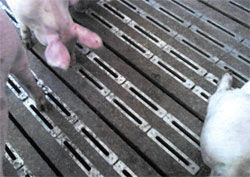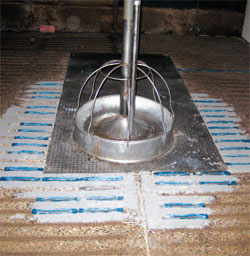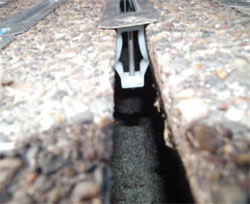



Concrete Slat Compliance. 1 – Slot Reducers
A report of BPEX trials testing new floor slot reduction and closure techniques for British pig production, published as No. 17 in its 'Research into Action' series.On-farm studies of concrete floors in pig buildings have found cases where the slot width exceeds the permitted maximum; often due to age or wear. UK farm assurance standards ensure that participating farms conform to the relevant legislation1. Farmers are, therefore, seeking remedial solutions and need to be confident of their efficacy.
A series of evaluation trials was commissioned by BPEX to look at slot reduction and closure techniques which have recently been made available commercially. These include slot reducer inserts, steel bar inserts, slot closure inserts and compounds applied to surfaces.
This publication refers to the first of these trials which consisted of assessing stainless steel slot reducers in four units around the country. The assessments measured the interaction of the pigs with the floor with respect to welfare and durability of the device over time. Real Welfare based assessments were used.
|
Real Welfare is an industry-led project funded by BPEX to help pig producers demonstrate pig welfare and boost productivity, using ‘welfare outcomes’ or ‘animal-based’ measures. These measures are:
|
Method
An open invitation was extended to potential suppliers of these devices to participate in this long-term evaluation. Four farms producing growers and finishers were used for the trial:
- one farm had full pen treatment
- three farms had partial pen treatment.
After installation, each farm had three visits over a period of several months, either by a veterinary surgeon or BPEX staff, to assess the welfare of the pigs using the Real Welfare outcomes measures as well as scoring for bursae on the legs. The producers were also asked for their feedback with regard to:
- ease of installation
- durability of the reducers
- methods for fixing the reducers
- general satisfaction, and
- suggestions for improvements.
Results



To date, there appear to be no significant differences in the key welfare measures, e.g. body marks, lameness, bursae and tail biting, between pigs housed with and without the reducers. Additional measures considered, such as pigs requiring a hospital pen and the use of enrichment, were also not significantly different.
It should be noted that the comparison is being made between pigs kept in pens with slot reducers installed versus the equivalent number and age of pigs in adjacent pens; the floors of these pens were often of sub-optimal condition. On some of the units, the ‘worst’ pens received the treatment (slot reducers), so the control pens may have had slats in reasonable condition.
There were no consistent trends across all units and no sustained trends at individual unit level. On some of the units, all slots in treatment pens were filled with slot reducers, while on others, reducers were applied in patches to repair areas where damage was present.
The slot reducers were generally perceived to be a good start but the following limitations with the trial batch were highlighted:
- The pigs’ ability to remove the reducers if they are not correctly installed
- Strong, commercial multipurpose adhesive has been found to be more successful than rubberised flexible adhesives to keep them in place
- The reducers used in the trial were not suitable for fitting to extremely wide gaps, eg greater than 25mm
- It is critical to ensure that pigs cannot get their snouts under the edges of the reducers, for example, if the short ends of the reducers are exposed
- Where the slat is badly corroded, creating a difference in level, this could result in the reducers becoming loose
- The profile of some slot sides meant that the fixing device initially used had limited success.
The manufacturer has now addressed these issues with an expanded range of products to match customers’ needs.
Conclusions
This work has confirmed that, when correctly installed:
- The inserts provide an effective means for correcting floors.
- The inserts meet current regulations and the Defra Code of Practice for the Welfare of Pigs without any negative impacts on the pigs.
- Both Defra and Animal Health and Veterinary Laboratories Agency staff were satisfied that the inserts are an acceptable solution to reducing the gap width of slots.
- When the correct combination of length of insert, grippers and resin were used the farmers found them to be a durable solution.
Next steps
BPEX is continuing its monitoring over the longer term.
August 2013








